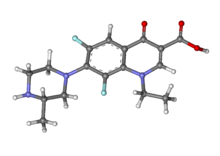 | |
 | |
| Clinical data | |
|---|---|
| Trade names | Maxaquin |
| AHFS/Drugs.com | Consumer Drug Information |
| MedlinePlus | a600002 |
| ATC code | |
| Pharmacokinetic data | |
| Protein binding | 10% |
| Elimination half-life | 8 hours |
| Identifiers | |
IUPAC name
| |
| CAS Number |
|
| PubChem CID | |
| DrugBank | |
| ChemSpider | |
| UNII |
|
| KEGG | |
| ChEBI | |
| ChEMBL | |
| CompTox Dashboard (EPA) | |
| ECHA InfoCard | 100.117.399 |
| Chemical and physical data | |
| Formula | C17H19F2N3O3 |
| Molar mass | 351.354 g·mol |
| 3D model (JSmol) | |
| Melting point | 239 to 240.5 °C (462.2 to 464.9 °F) |
SMILES
| |
InChI
| |
| (verify) | |
Lomefloxacin hydrochloride (sold under the following brand names in English-speaking countries Maxaquin, Okacyn, Uniquin) is a fluoroquinolone antibiotic used to treat bacterial infections including bronchitis and urinary tract infections. It is also used to prevent urinary tract infections prior to surgery. Lomefloxacin is associated with phototoxicity and central nervous system adverse effects.
In October 2008, the FDA added the following black box warning to the product insert for Maxaquin: "Lomefloxacin is unique in that it forms a magnesium chelate with itself. The chelate is formed between the 2-carbonyl group of two separate lomefloxacin molecules."
It was patented in 1983 and approved for medical use in 1989.
References
- Al-Wabli RI (2017). "Lomefloxacin". Profiles of Drug Substances, Excipients and Related Methodology. Vol. 42. Elsevier. pp. 193–240. doi:10.1016/bs.podrm.2017.02.004. ISBN 978-0-12-812226-6. ISSN 1871-5125. PMID 28431777.
Lomefloxacin elimination half-life is about 7–8 h and is prolonged in patients with renal impairment.
- Rubinstein E (2001). "History of quinolones and their side effects". Chemotherapy. 47 (Suppl 3): 3–8, discussion 44-8. doi:10.1159/000057838. PMID 11549783. S2CID 21890070.
- Fischer J, Ganellin CR (2006). Analogue-based Drug Discovery. John Wiley & Sons. p. 500. ISBN 9783527607495.
| Antibacterials that inhibit protein synthesis (J01A, J01B, J01F, J01G, QJ01XQ) | |||||||||||||||
|---|---|---|---|---|---|---|---|---|---|---|---|---|---|---|---|
| 30S |
| ||||||||||||||
| 50S | |||||||||||||||
| |||||||||||||||
| Ophthalmologicals: anti-infectives (S01A) | |
|---|---|
| Antibiotics |
|
| Sulfonamides | |
| Antivirals | |
| Fluoroquinolones | |
| Other | |
| Antibacterials that inhibit nucleic acid (J01E, J01M) | |||||||||||||||||
|---|---|---|---|---|---|---|---|---|---|---|---|---|---|---|---|---|---|
| Antifolates (inhibit bacterial purine metabolism, thereby inhibiting DNA and RNA synthesis) |
| ||||||||||||||||
| Quinolones (inhibit bacterial topoisomerase and/or DNA gyrase, thereby inhibiting DNA replication) |
| ||||||||||||||||
| Anaerobic DNA inhibitors |
| ||||||||||||||||
| RNA synthesis |
| ||||||||||||||||
| |||||||||||||||||
This systemic antibiotic-related article is a stub. You can help Misplaced Pages by expanding it. |